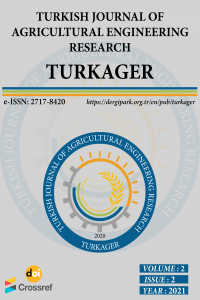Research Article
Year 2021,
Volume: 2 Issue: 2, 390 - 402, 31.12.2021
Abstract
The mathematical analysis for estimating the performance rate "RP" of chain-type trenching machine was studied. The mathematical analysis ended with an equation for this type. This mathematical equation was checked under different operating conditions. The practical study of the performance rate showed that the deviation of the theoretical performance rate from the actual performance rate ranged from -3.4 to +2% only for the 150.7 cm and 120.7 cm trench depth respectively. The machine field efficiency ranged from 46.7 to 57% for the 150.7 cm and 120.7 cm depth respectively. It also showed an increase in machine field efficiency by decreasing the trench depth.
References
- Day DA (1973). Construction equipment guide. John Wiley and Sons.,Inc., N. Y., USA, 206-208.
- Diep DD (2017). Analysis the Factors Affecting Conveyance Rate of Unbucket Chain Trenching Machine. Agricultural, Forest and Transport Machinery and Technologies, 4(1): 38-44.
- Donahue RL, Miller RW and Shickluna GC (1985). Soil an introduction to soil and plant growth. 4th Ed. Prentice Hall, Inc., Englewood cliffs, New Jersey, USA. 98-106.
- Du Y, Dorneich MC and Steward B (2016). Virtual operator modeling method for excavator trenching. Automation in Construction, 70: 14-25.
- i-bidder.com 2015. Barth holland k171 trencher. [Online] Available from: https://www.i-bidder.com/en-gb/auction-catalogues/ml/catalogue-id-morris10019/lot-dd3f8267-bddc-47be-ab61-a50900a797df. (Accessed November 24, 2021).
- Jia J, Jia and Schmidt (2018). Soil dynamics and foundation modeling. Springer, New York.
- Kovalenko P, Rokochinskiy A, Mazhayskiy Y, Volk P, Volk L and Chernikova O (2020). Construction and agricultural drainage parameter optimization considering economic and environmental requirements. Engineering for Rural Development, 19: 1009-1017.
- Peurifoy RL (1970). Construction planning, equipment, and methods. 2nd ed. McGraw, Hill Kogakusha, Ltd., Tokyo, Japan, pp 695.
- Reddy Y and Shailesh P (2018). Design and analysis of excavator bucket tooth. International Journal of Modern Trends in Engineering and Research, 5(4): 79-86.
- Shady AM (1989). Irrigation drainage and flood control in Canada. Canadian international development agency, Quebec, Canada.
- Schaufelberger JE and Migliaccio GC (2019). Construction equipment management. Routledge.
- Schwab GO, Frevert RK, Edminster TW and Barnes KK (1982). Soil and water conservation engineering. Soil Science, 134(2): 146.
- Sitorus PE, Ko JH and Kwon OS (2016). Parameter study of chain trenching machines of Underwater Construction Robots via analytical model. In OCEANS 2016 MTS/IEEE Monterey (pp. 1-6). IEEE.
- Spencer A, Machin J and Jackson E (2007). Rock cutting With the T750 super trenching. Unmanned Intervention, New Orleans, LA, 30.
- Vlotman WF, Smedema LK and Rycroft DW (2020). Modern land drainage: Planning, design and management of agricultural drainage systems. CRC Press.
Year 2021,
Volume: 2 Issue: 2, 390 - 402, 31.12.2021
Abstract
References
- Day DA (1973). Construction equipment guide. John Wiley and Sons.,Inc., N. Y., USA, 206-208.
- Diep DD (2017). Analysis the Factors Affecting Conveyance Rate of Unbucket Chain Trenching Machine. Agricultural, Forest and Transport Machinery and Technologies, 4(1): 38-44.
- Donahue RL, Miller RW and Shickluna GC (1985). Soil an introduction to soil and plant growth. 4th Ed. Prentice Hall, Inc., Englewood cliffs, New Jersey, USA. 98-106.
- Du Y, Dorneich MC and Steward B (2016). Virtual operator modeling method for excavator trenching. Automation in Construction, 70: 14-25.
- i-bidder.com 2015. Barth holland k171 trencher. [Online] Available from: https://www.i-bidder.com/en-gb/auction-catalogues/ml/catalogue-id-morris10019/lot-dd3f8267-bddc-47be-ab61-a50900a797df. (Accessed November 24, 2021).
- Jia J, Jia and Schmidt (2018). Soil dynamics and foundation modeling. Springer, New York.
- Kovalenko P, Rokochinskiy A, Mazhayskiy Y, Volk P, Volk L and Chernikova O (2020). Construction and agricultural drainage parameter optimization considering economic and environmental requirements. Engineering for Rural Development, 19: 1009-1017.
- Peurifoy RL (1970). Construction planning, equipment, and methods. 2nd ed. McGraw, Hill Kogakusha, Ltd., Tokyo, Japan, pp 695.
- Reddy Y and Shailesh P (2018). Design and analysis of excavator bucket tooth. International Journal of Modern Trends in Engineering and Research, 5(4): 79-86.
- Shady AM (1989). Irrigation drainage and flood control in Canada. Canadian international development agency, Quebec, Canada.
- Schaufelberger JE and Migliaccio GC (2019). Construction equipment management. Routledge.
- Schwab GO, Frevert RK, Edminster TW and Barnes KK (1982). Soil and water conservation engineering. Soil Science, 134(2): 146.
- Sitorus PE, Ko JH and Kwon OS (2016). Parameter study of chain trenching machines of Underwater Construction Robots via analytical model. In OCEANS 2016 MTS/IEEE Monterey (pp. 1-6). IEEE.
- Spencer A, Machin J and Jackson E (2007). Rock cutting With the T750 super trenching. Unmanned Intervention, New Orleans, LA, 30.
- Vlotman WF, Smedema LK and Rycroft DW (2020). Modern land drainage: Planning, design and management of agricultural drainage systems. CRC Press.
There are 15 citations in total.
Details
| Primary Language | English |
|---|---|
| Subjects | Agricultural Engineering |
| Journal Section | Research Articles |
| Authors | |
| Publication Date | December 31, 2021 |
| Submission Date | September 23, 2021 |
| Acceptance Date | November 26, 2021 |
| Published in Issue | Year 2021 Volume: 2 Issue: 2 |
International peer double-blind reviewed journal
The articles in the Turkish Journal of Agricultural Engineering Research are open access articles and the articles are licensed under a Creative Commons Attribution 4.0 International License (CC-BY-NC-4.0)(https://creativecommons.org/licenses/by-nc/4.0/deed.en). This license allows third parties to share and adapt the content for non-commercial purposes with proper attribution to the original work. Please visit for more information this link https://creativecommons.org/licenses/by-nc/4.0/
Turkish Journal of Agricultural Engineering Research (TURKAGER) is indexed/abstracted in Information Matrix for the Analysis of Journals (MIAR), EBSCO, CABI, Food Science & Technology Abstracts (FSTA), CAS Source Index (CASSI).Turkish Journal of Agricultural Engineering Research (TURKAGER) does not charge any application, publication, or subscription fees.
Publisher: Ebubekir ALTUNTAŞ
For articles citations to the articles of the Turkish Journal of Agricultural Engineering Research (TURKAGER), please click:


